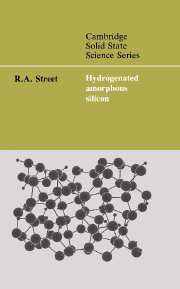Book contents
- Frontmatter
- Contents
- Preface
- 1 Introduction
- 2 Growth and structure of amorphous silicon
- 3 The electronic density of states
- 4 Defects and their electronic states
- 5 Substitutional doping
- 6 Defect reactions, thermal equilibrium and metastability
- 7 Electronic transport
- 8 The recombination of excess carriers
- 9 Contacts, interfaces and multilayers
- 10 Amorphous silicon device technology
- References
- Index
1 - Introduction
Published online by Cambridge University Press: 13 March 2010
- Frontmatter
- Contents
- Preface
- 1 Introduction
- 2 Growth and structure of amorphous silicon
- 3 The electronic density of states
- 4 Defects and their electronic states
- 5 Substitutional doping
- 6 Defect reactions, thermal equilibrium and metastability
- 7 Electronic transport
- 8 The recombination of excess carriers
- 9 Contacts, interfaces and multilayers
- 10 Amorphous silicon device technology
- References
- Index
Summary
Early research
Hydrogenated amorphous silicon (a-Si: H) was a late arrival to the research on amorphous semiconductors, which began to flourish during the 1950s and 1960s; studies of insulating oxide glasses, of course, go back much further. Interest in the amorphous semiconductors developed around the chalcogenides, which are materials containing the elements sulfur, selenium and tellurium; examples are As2 Se3, GeS2 etc. The chalcogenides are glasses which may be formed by cooling from the melt, with structure similar to the oxides but with smaller energy band gaps. Research in these amorphous semiconductors addressed the question of how the disorder of the noncrystalline structure influences the electronic properties. The study of chalcogenides was further promoted by the introduction of xerographic copying machines. Xerography was invented in 1938 and the first successful copier was made in 1956, using selenium as the photoconductive material.
A-Si:H was first made in the late 1960s. Before that time there was research on amorphous silicon without hydrogen, which was prepared by sputtering or by thermal evaporation. The unhydrogenated material has a very high defect density which prevents doping, photoconductivity and the other desirable characteristics of a useful semiconductor. Electronic measurements were mostly limited to the investigation of conduction through the defect states.
Chittick and coworkers in the UK were the first to make a-Si:H, using glow discharge as the deposition technique (Chittick, Alexander and Sterling 1969). Silane gas (SiH4) is excited by an electrical plasma which causes the gas molecules to dissociate the deposit on heated substrates.
Information
- Type
- Chapter
- Information
- Hydrogenated Amorphous Silicon , pp. 1 - 17Publisher: Cambridge University PressPrint publication year: 1991
Accessibility standard: Unknown
Why this information is here
This section outlines the accessibility features of this content - including support for screen readers, full keyboard navigation and high-contrast display options. This may not be relevant for you.Accessibility Information
- 2
- Cited by
